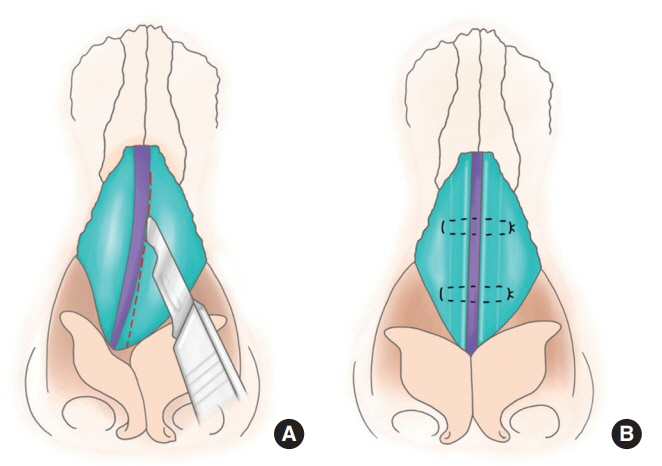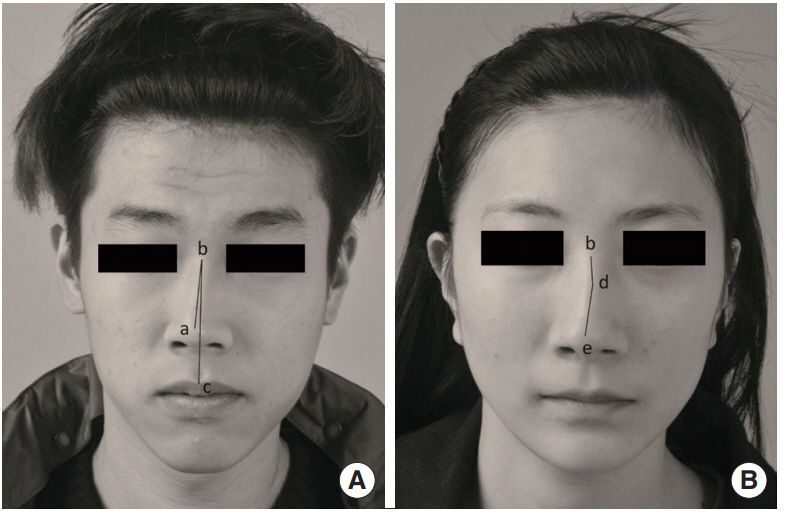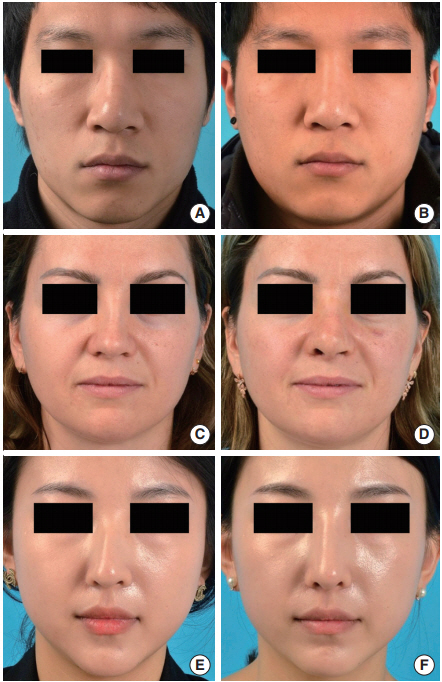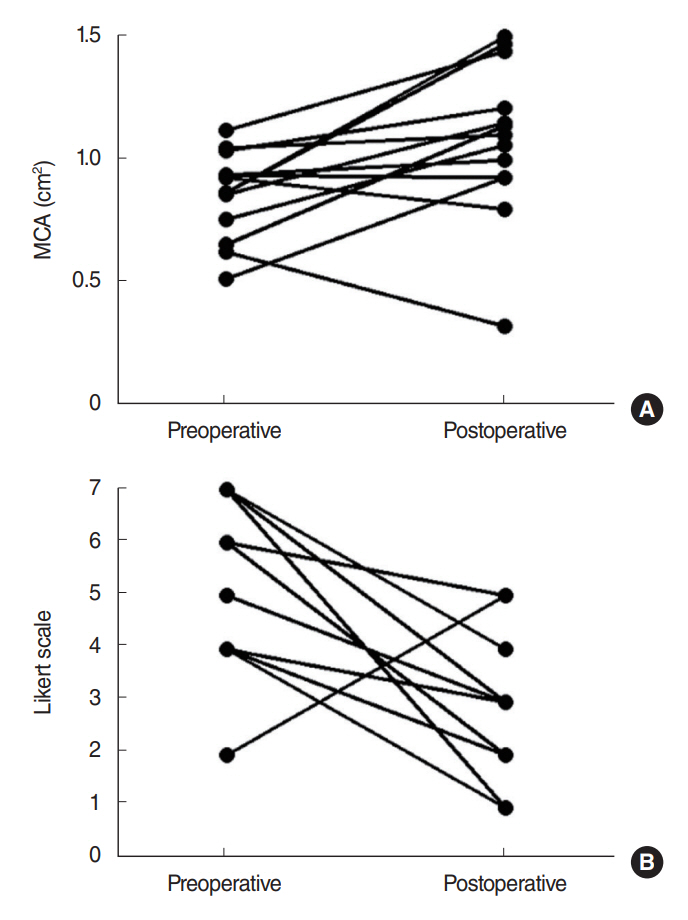Clin Exp Otorhinolaryngol.
2018 Dec;11(4):275-280. 10.21053/ceo.2017.01816.
Triangular Resection of the Upper Lateral Cartilage for Middle Vault Deviation
- Affiliations
-
- 1Department of Otorhinolaryngology-Head and Neck Surgery, Samsung Medical Center, Sungkyunkwan University School of Medicine, Seoul, Korea. siamkhy@gmail.com
- KMID: 2439854
- DOI: http://doi.org/10.21053/ceo.2017.01816
Abstract
OBJECTIVES
Middle vault deviation has a significant effect on the aesthetic and functional aspects of the nose, and its management continues to be a challenge. Spreader graft and its modification techniques have been focused, but there has been scarce consideration for removing surplus portion and balancing the upper lateral cartilage (ULC). This study aimed to report the newly invented triangular-shaped resection technique ("triangular resection") of the ULC and to evaluate its efficacy for correcting middle vault deviation.
METHODS
A retrospective study included 17 consecutive patients who presented with middle vault deviation and underwent septorhinoplasty by using triangular resection at a tertiary academic hospital from February 2014 and March 2016. Their outcomes were evaluated pre- and postoperatively including medical photographs, acoustic rhinometry and subjective nasal obstruction using a 7-point Likert scale.
RESULTS
The immediate outcomes were evaluated around 1 month after surgery, and long-term outcomes were available in 12 patients; the mean follow-up period was 9.1 months. Nasal tip deviation angle was reduced from 5.66° to 2.37° immediately (P < 0.001). Middle vault deviation also improved from 169.50° to 177.24° (P < 0.001). Long-term results were 2.49° (P=0.015) for nasal tip deviation and 178.68° (P=0.002) for middle vault deviation. The aesthetic outcome involved a complete correction in eight patients (47.1%), a minimally visible deviation in seven patients (41.2%) and a remaining residual deviation in two patients (11.8%). Pre- and postoperative minimal cross-sectional areas (summation of the right and left sides) were 0.86 and 1.07, respectively (P=0.021). Fifteen patients answered about their nasal obstruction symptoms and the median symptom score had alleviated from 6.0 to 3.0 (P=0.004).
CONCLUSION
Triangular resection of the ULC is a simple and effective method for correcting middle vault deviation and balancing the ULCs without complications as internal nasal valve narrowing.
MeSH Terms
Figure
Cited by 1 articles
-
One-Unit Osteotomy to Correct Deviated Bony Dorsum
Byung Kil Kim, Yujin Heo, Song I Park, Sang Duk Hong, Yong Gi Jung, Hyo Yeol Kim
Clin Exp Otorhinolaryngol. 2023;16(1):59-66. doi: 10.21053/ceo.2022.01095.
Reference
-
1. Constantinides MS, Adamson PA, Cole P. The long-term effects of open cosmetic septorhinoplasty on nasal air flow. Arch Otolaryngol Head Neck Surg. 1996; Jan. 122(1):41–5.
Article2. Ozturan O. Techniques for the improvement of the internal nasal valve in functional-cosmetic nasal surgery. Acta Otolaryngol. 2000; Mar. 120(2):312–5.
Article3. Potter JK. Correction of the crooked nose. Oral Maxillofac Surg Clin North Am. 2012; Feb. 24(1):95–107.
Article4. Pontius AT, Leach JL Jr. New techniques for management of the crooked nose. Arch Facial Plast Surg. 2004; Jul-Aug. 6(4):263–6.
Article5. Cerkes N. The crooked nose: principles of treatment. Aesthet Surg J. 2011; Feb. 31(2):241–57.
Article6. Kang JM, Nam ME, Dhong HJ, Kim HY, Chung SK, Kim JH. Modified mattress suturing technique for correcting the septal high dorsal deviation around the keystone area. Am J Rhinol Allergy. 2012; May-Jun. 26(3):227–32.
Article7. Okur E, Yildirim I, Aydogan B, Akif Kilic M. Outcome of surgery for crooked nose: an objective method of evaluation. Aesthetic Plast Surg. 2004; Jul-Aug. 28(4):203–7.
Article8. Erdem T, Ozturan O. Objective measurement of the deviated nose and a review of surgical techniques for correction. Rhinology. 2008; Mar. 46(1):56–61.9. Zuo L, Jing S, Zhou C, Dai Z, Yang S, Sun B, et al. Tension-relaxing method-A simplified revision of the endoscopic septoplasty technique: for both aesthetic appearance and functionality. Am J Rhinol Allergy. 2015; Jul-Aug. 29(4):e105–11.
Article10. Jin HR, Lee JY, Shin SO, Choi YS, Lee DW. Key maneuvers for successful correction of a deviated nose in Asians. Am J Rhinol. 2006; Nov-Dec. 20(6):609–14.
Article11. Sheen JH. Spreader graft: a method of reconstructing the roof of the middle nasal vault following rhinoplasty. Plast Reconstr Surg. 1984; Feb. 73(2):230–9.12. Yoo S, Most SP. Nasal airway preservation using the autospreader technique: analysis of outcomes using a disease-specific quality-of-life instrument. Arch Facial Plast Surg. 2011; Jul-Aug. 13(4):231–3.13. Saedi B, Amali A, Gharavis V, Yekta BG, Most SP. Spreader flaps do not change early functional outcomes in reduction rhinoplasty: a randomized control trial. Am J Rhinol Allergy. 2014; Jan-Feb. 28(1):70–4.
Article14. Moubayed SP, Most SP. The autospreader flap for midvault reconstruction following dorsal Hump resection. Facial Plast Surg. 2016; Feb. 32(1):36–41.
Article15. Sahin MS, Ozmen OA. Early results and description of a new modification of spreader graft to enlarge nasal valve area: modified triangular spreader graft. J Craniofac Surg. 2016; Jun. 27(4):839–42.16. Kim L, Papel ID. Spreader grafts in functional rhinoplasty. Facial Plast Surg. 2016; Feb. 32(1):29–35.
Article17. Jang YJ, Alfanta EM. Rhinoplasty in the Asian nose. Facial Plast Surg Clin North Am. 2014; Aug. 22(3):357–77.
Article18. Li D, An Y, Yang X. An overview of Asian rhinoplasty. Ann Plast Surg. 2016; Feb. 77 Suppl 1:S22–4.
Article19. Sirinoglu H, Yesiloglu N, Ersoy B. A new perspective for spreader graft use in severely deviated septum: is septal continuity an obligation for a stable and straight nasal septum. Facial Plast Surg. 2016; Aug. 32(4):460–8.
Article20. Kovacevic M, Riedel F, Goksel A, Wurm J. Options for middle vault and dorsum restoration after hump removal in primary rhinoplasty. Facial Plast Surg. 2016; Aug. 32(4):374–83.
Article21. Xavier R, Azeredo-Lopes S, Papoila A. Spreader grafts: functional or just aesthetical. Rhinology. 2015; Dec. 53(4):332–9.
Article
- Full Text Links
- Actions
-
Cited
- CITED
-
- Close
- Share
- Similar articles
-
- One-Unit Osteotomy to Correct Deviated Bony Dorsum
- A Case of Congenital Defect of the Lateral Crus of the Lower Lateral Cartilage
- Correction of the deviated tip and columella in crooked nose
- The Effect of Monocular recession and Resection in Exodeviations: Comparison between Primary, Right, Left, Up, Down and Near Gaze
- Correction of the plunging nasal tip: 7CASES





